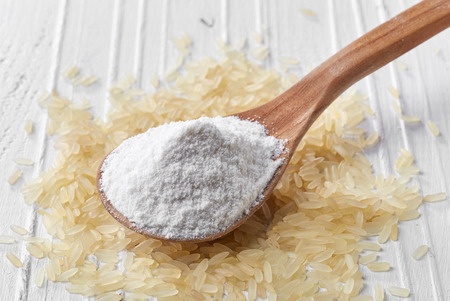
Rice flour is now the natural alternative for product developers looking to replace wheat, barley and rye flours so that coeliacs (celiacs) can enjoy a wide range of exciting products. Given that alternatives have long been sought for a wide range of flours in a host of products, the development of rice flour has become one of the major innovations especially in the Far East. Rice flour serves is as reliable a source of readily digestible protein as any other especially in processed foods such as noodles.
Rice flour is prepared from either or both brown and white rice and is finely milled as for any other flour. It is not like rice starch which is produced by steeping rice in lye (sodium hydroxide solution).
Properties
Usually creamy to ivory in colour.
No association with allergens which makes rice flour hypoallergenic.
Neutral in flavour. Ideal in many respects because of its sensory blandness.
Uses For Rice Flour
Rice flour is regularly used in south-eastern cooking for making noodles but is versatile enough to be employed in both sweet and savoury dishes. Great for puddings, biscuits, bars and even baked goods. From a functional perspective, it behaves like cornflower in thickening sauces and gravies.
Noodles are one of the main foods of South-eastern and Far Eastern cuisine. They are noted for their high levels of nutrition and the ability to combine them with a number of sauces. This has led them to becoming a major fast food because of their convenience, versatility and range of flavour options.
Indica rice has an amylose content higher than 25 per cent and has become widely used for making gluten-free noodles. Its high amylose content creates a relatively high degree of rigidity and toughness to the cooked noodle. It does not lose its shape or become flabby during cooking. Another benefit is that the stickiness of the noodle surface is lower than when made with other flours and cooking loss is reduced to a minimum (Lu et al., 2009).
Unfortunately, if the amylose content is to high means the viscosity of the starch paste and the expansion of any gelatinized rice starts to drop. That means the paste temperature rises and produces loss in sensory acceptability and makes it less palatable.
A more suitable alternative is rice flour obtained from Japonica rice which can be partially mixed with Indica rice flour to modify the noodle texture. Japonica rice flour has an amyloswe content which is less than 20%. Japonica rice on its own is not acceptable because it retrogrades more slowly after gelatinization compared to Indica rice. That makes the paste too sticky for rice noodle production on its own. Having said that, not all is lost with Japonica rice noodles. The Japanese and Koreans actually prefer japonica rice because of its reasonable level of elasticity and stickiness and so seek out products where the balance in rice flours is acceptable (Champagne et al., 2010; Feng et al., 2017).
Manufacturers of rice flour have improved its functional properties by seeking out methods of processing that modify and rearrange the starch molecules so that they produce less sticky pastes. They’ve also looked at those components naturally found with starch such as protein and lipid which also affect the starch properties (Gurjal & Rosell, 2004; Low et al., 2020).
Rice flour can be mixed with hydrocolloids and gums such as hydroxypropyl methylcellulose which increases its texture quality (Kadan et al., 2001; Sivaramakrishnan et al., 2004).
Fermentation Of Rice Flour
One approach to improving rice flour for functional use is to ferment the rice grain so that the structural components of the grain are altered. This also improves the nutritional profile too. Natural fermentation and acidification not only prevents microbial spoilage, but also affects the amorphous regions of the starch granules that help with gelatinization during cooking, making the texture of the noodles elastic and chewy (Lu et al., 2005).
Use Of Rice Flour In Bars
A useful ingredient for providing mouthfeel and helping to bind other ingredients – used in bars under the brand Nakd.
The nutritional data per 100g when uncooked is:-
Energy: 350 kcal/1480 kJ
Fat: 1.4g of which saturates are 0.4g, polyunsaturated fat and monounsaturated fat are both 0.4g.
Carbohydrates: 77g of which sugars are 0.2g
Protein: 6 – 8g depending on source.
The mineral content is 8% RDA magnesium and the potassium content is on average 76mg/100g.
There is a trace amount of salt if any.
Reference
Champagne, E. T., Bett-Garber, K. L., Fitzgerald, M. A., Grimm, C. C., Lea, J., Ohtsubo, K. I., … & Reinke, R. (2010). Important sensory properties differentiating premium rice varieties. Rice, 3(4), pp. 270-281 (Article).
Feng, F., Li, Y., Qin, X., Liao, Y., & Siddique, K. H. (2017). Changes in rice grain quality of indica and japonica type varieties released in China from 2000 to 2014. Frontiers in plant science, 8, 1863. (Article)
Gujral, H. S., & Rosell, C. M. (2004). Functionality of rice flour modified with a microbial transglutaminase. Journal of Cereal Science, 39(2), pp. 225-230.
Kadan, R. S., Robinson, M. G., Thibodeaux, D. P., & Pepperman Jr, A. B. (2001). Texture and other physicochemical properties of whole rice bread. Journal of Food Science, 66(7), pp. 940-944 (Article).
Low, Y. K., Effarizah, M. E., & Cheng, L. H. (2020). Factors influencing rice noodles qualities. Food Reviews International, 36(8), pp. 781-794 (Article).
Lu, Z. H., Li, L. T., Min, W. H., Wang, F., & Tatsumi, E. (2005). The effects of natural fermentation on the physical properties of rice flour and the rheological characteristics of rice noodles. International journal of food science & technology, 40(9), pp. 985-992 (Article).
Lu, Z. H., Sasaki, T., Li, Y. Y., Yoshihashi, T., Li, L. T., & Kohyama, K. (2009). Effect of amylose content and rice type on dynamic viscoelasticity of a composite rice starch gel. Food Hydrocolloids, 23(7), pp. 1712-1719 (Article).
Sivaramakrishnan, H. P., Senge, B., & Chattopadhyay, P. K. (2004). Rheological properties of rice dough for making rice bread. Journal of Food Engineering, 62(1), pp. 37-45 (Article).

Leave a Reply